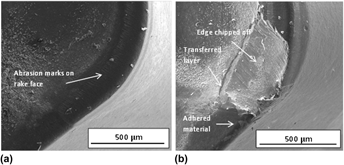Crossref Citations
This article has been cited by the following publications. This list is generated based on data provided by
Crossref.
Wang, Dong
Zhao, Jun
Cao, Yan
Xue, Chao
and
Bai, Yu
2016.
Wear behavior of an Al2O3/TiC/TiN micro-nano-composite ceramic cutting tool in high-speed turning of ultra-high-strength steel 300 M.
The International Journal of Advanced Manufacturing Technology,
Vol. 87,
Issue. 9-12,
p.
3301.
Xu, Qingzhong
Zhao, Jun
and
Ai, Xing
2017.
Fabrication and cutting performance of Ti(C,N)-based cermet tools used for machining of high-strength steels.
Ceramics International,
Vol. 43,
Issue. 8,
p.
6286.
Wang, Dong
Xue, Chao
Cao, Yan
and
Zhao, Jun
2017.
Fabrication and cutting performance of an Al2O3/TiC/TiN ceramic cutting tool in turning of an ultra-high-strength steel.
The International Journal of Advanced Manufacturing Technology,
Vol. 91,
Issue. 5-8,
p.
1967.
Badiger, Pradeep V
Desai, Vijay
Ramesh, M R
Prajwala, B K
and
Raveendra, K
2018.
Effect of cutting parameters on tool wear, cutting force and surface roughness in machining of MDN431 alloy using Al and Fe coated tools.
Materials Research Express,
Vol. 6,
Issue. 1,
p.
016401.
Sharma, Neeraj
and
Gupta, Kapil
2019.
Influence of coated and uncoated carbide tools on tool wear and surface quality during dry machining of stainless steel 304.
Materials Research Express,
Vol. 6,
Issue. 8,
p.
086585.
Badiger, Pradeep V.
Desai, Vijay
Ramesh, M. R.
Prajwala, B. K.
and
Raveendra, K.
2019.
Cutting Forces, Surface Roughness and Tool Wear Quality Assessment Using ANN and PSO Approach During Machining of MDN431 with TiN/AlN-Coated Cutting Tool.
Arabian Journal for Science and Engineering,
Vol. 44,
Issue. 9,
p.
7465.
Xu, Qingzhong
Zhao, Jun
Ai, Xing
Huang, Weimin
and
Wang, Guijie
2019.
Optimum selection of tool materials for machining of high-strength steels based on fuzzy comprehensive evaluation method.
Proceedings of the Institution of Mechanical Engineers, Part B: Journal of Engineering Manufacture,
Vol. 233,
Issue. 1,
p.
145.
Badiger, Pradeep V.
Desai, Vijay
Ramesh, M. R.
Vinyas, M.
Santhosh, C. M.
Prajwala, B. K.
and
Raveendra, L.
2020.
Influence of Ti coated tools on process parameters in turning process of MDN431.
Vol. 2205,
Issue. ,
p.
040019.
Kamatchi Hariharan, M.
Anderson, A.
Ravi Kumar, K.
and
Senthilkumar, A.
2021.
Optimization of machining parameters in turning of LM6 high silicon aluminium alloy using aluminium titanium nitride and diamond like carbon coated carbide tool.
Materials Today: Proceedings,
Vol. 45,
Issue. ,
p.
5853.
Paturi, Uma Maheshwera Reddy
Cheruku, Suryapavan
Pasunuri, Venkat Phani Kumar
and
Salike, Sriteja
2021.
Modeling of tool wear in machining of AISI 52100 steel using artificial neural networks.
Materials Today: Proceedings,
Vol. 38,
Issue. ,
p.
2358.
Kamatchi Hariharan, M.
Rajkamal, M.D.
Ravikumar, K.
and
Sheik Mohammed, M.
2022.
Investigation on effect of TiN, TiAlN & DLC-triple layer coated carbide tool in machining of Al-Si 4032 alloy.
Materials Today: Proceedings,
Vol. 59,
Issue. ,
p.
39.
Banda, Tiyamike
Liu, Yu-chen
Farid, Ali Akhavan
and
Lim, Chin Seong
2023.
A machine learning model for flank wear prediction in face milling of Inconel 718.
The International Journal of Advanced Manufacturing Technology,
Vol. 126,
Issue. 3-4,
p.
935.
Babe, Itemogeng Bernatt
Gupta, Kapil
and
Chaubey, Sujeet Kumar
2023.
Sustainable Dry Machining of Stainless Steel with Microwave-Treated Tungsten Carbide Cutting Tools.
Micromachines,
Vol. 14,
Issue. 6,
p.
1148.
Thobane, Thabiso Moral
Chaubey, Sujeet Kumar
and
Gupta, Kapil
2023.
Analysis of Tool Wear and Chip Morphology during Turning of AZ31B Magnesium Alloy under Dry Environment.
Journal of Manufacturing and Materials Processing,
Vol. 7,
Issue. 5,
p.
187.
Bag, Rabinarayan
Panda, Amlana
Sahoo, Ashok Kumar
and
Kumar, Ramanuj
2023.
Sustainable High-Speed Hard Machining of AISI 4340 Steel Under Dry Environment.
Arabian Journal for Science and Engineering,
Vol. 48,
Issue. 3,
p.
3073.
Katna, Rahul
Suhaib, Mohd
and
Agrawal, Narayan
2023.
Performance of non-edible oils as cutting fluids for green manufacturing.
Materials and Manufacturing Processes,
Vol. 38,
Issue. 12,
p.
1531.
Khan, Muhammad Ayyaz
Jaffery, Syed Husain Imran
Khan, Muhammad Ali
Faraz, Muhammad Iftikhar
and
Mufti, Sachhal
2023.
Multi-Objective Optimization of Micro-Milling Titanium Alloy Ti-3Al-2.5V (Grade 9) Using Taguchi-Grey Relation Integrated Approach.
Metals,
Vol. 13,
Issue. 8,
p.
1373.
Khan, Muhammad Ayyaz
Khan, Muhammad Ali
Aziz, Shahid
Faraz, Muhammad Iftikhar
Tahir, Abdul Malik
Jaffery, Syed Husain Imran
and
Jung, Dong-Won
2023.
Experimental Evaluation of Surface Roughness, Burr Formation, and Tool Wear during Micro-Milling of Titanium Grade 9 (Ti-3Al-2.5V) Using Statistical Evaluation Methods.
Applied Sciences,
Vol. 13,
Issue. 23,
p.
12875.
Putra Pangestu, Kidung Tirtayasa
Putri Lingga, Christina Dekawati
and
Darmawan, Wayan
2023.
Peningkatan Masa Pakai Pisau Gergaji Tungsten Carbide Berpelapis dalam Pemotongan Medium Density Fiberboard.
Jurnal Ilmu Pertanian Indonesia,
Vol. 28,
Issue. 2,
p.
222.
Veerappan, G.
Logesh, Kamaraj
Chaturvedi, Rishabh
Ravichandran, Manickam
Mohanavel, Vinayagam
Hossain, Ismail
Kannan, Sathish
Alotaibi, Majed A.
and
Seikh, Asiful H.
2024.
Experimental and numerical analysis on the cutting force, cutting temperature, and tool wear of alloy steel (4340) during turning process.
AIP Advances,
Vol. 14,
Issue. 11,
